|
|
|
|||
|
|
||||
|
|
||||
| The (Jet)X Files | ||||
|
|
HOME | SITE MAP | FORUM | CONTACT |
|
||
|
ABOUT | MOTORS | MODELS | ARCHIVE | HISTORY | STORE | FAQ | LINKS
|
|
|
|
|
|
|||||||||||||||||||||||||||||||||||||||||||||||||||||||||||||||||||||
|
The (Jet)X Files 22
(October 2004)
by Roger Simmonds Reprinted from SAM 35 Speaks, October 2004 Potpourri First, Sir Simeon Bull unearthed this gem of an illustration [below right], which was featured in ‘Model News’, in the December 1949 Aeromodeller. John Miller Crawford has done wonders in cleaning it up; the definition of the original was poor and Sir Simeon’s magazine had unfortunately not worn too well. The text reads, “Albert Hatfull of Edmonton sends this picture of his Jetex 100 powered 24-in. span model. All up weight is 1¾ oz. Note in particular the laudable efforts to give some sort of semi-scale appearance with a cockpit and open jet orifice to the pod. Other interesting features are endplates to the wings and tailplane, which embodies butterfly layout – a style that is fast growing in popularity”. Howbeit, the design is not particularly innovative, and the endorsement of its semi-scale appearance would have appeared quite dated even at the time, as modelling fashions, influenced by iconoclastic competitors, were changing fast. The model is nevertheless of much historical interest. Was this Albert Hatfull’s first Jetex model? Does anyone have details of its construction? Is there a plan out there somewhere? |
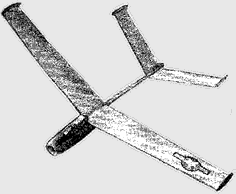
- Aeromodeller, Dec. 1949
|
|||||||||||||||||||||||||||||||||||||||||||||||||||||||||||||||||||||
|
Second, amongst the many photos Mike Ingram so kindly sent me was this one of a rather battered D.H. 108 Swallow that was part of David Carpenter’s Jetex Exhibition at the Southampton Hall of Aviation. It has been also been splendidly renovated (again by John); in the original the contrast was very poor and a pillar obscured the fin. Mike himself did not know where this model came from. It isn’t the one featured in the early advertisement for the Jetex 350 (see March’s (Jet)X Files) as the shape of the canopy and the registration number are different. It could be D P Golding’s 1952 AP design for Jetex 100; the fuselage appears appropriately ‘solid’ and the motor is internal. The canopy and nose are those of the last prototype (VW 120) which, after its moments of glory in 1948 and 1949, disintegrated and crashed in 1950. The real machine was lethal, but it made for a most beguiling model. |
 (note the hatch for the internal motor)
- Mike Ingram
|
|||||||||||||||||||||||||||||||||||||||||||||||||||||||||||||||||||||
|
Finally, (in this section), the illustration on the right is taken from a Gamages advert in the January 1953 Meccano Magazine. Now the Jetex Interceptor ARTF is familiar to all of us, but this one, which is earlier and contemporaneous with the ‘Tailored’ Voodoo, is far less familiar. I would guess the ‘F.B. 109’ is a genuine Wilmot Mansour product, as it came complete with a Jetex 50B that may have been at least partially enclosed (look at the air intakes). It was quite expensive, but note that one could save money by flying it as a catapult glider (“reaching heights up to 300 feet”). I wonder how it flew. Was this product exclusive to Gamages? Did any reader have one as a present from a rich and indulgent relative? SAM Gala, Old Warden, August 2004 Due to personal commitments I could attend only on Saturday. It is a real pity I missed Peter Tolhurst and his interpretation of Arch J Hall’s CO2 Speedjet (see June’s column). Peter writes: “I had a mixed Rapier day. It was hot on Sunday but with quite a wind coming off the copse with much turbulence. Neither the Slinki [an all sheet flying wing] nor my duration model liked the wind. I used catapult launch for my Speedjet (finished in red with a black cockpit, all the better for locating in the grass) to mitigate the turbulence, and an 80 mN Rapier L1 powered it well. Sadly all too well, as on its second flight the last I saw of it was at a hundred feet or so above Hangar One. Not bad I suppose for a 7.5-inch span model. I estimate, using a ‘green bottle’ to size the plan, that my model was about the same size as the original 1950 version, which must have been lethal powered by CO2!! Unfortunately I didn’t take a photo for posterity and I hadn’t put my name on it! [tut tut!]. I must make another one, but this time I will take a photo first.” Andy Blackwell also reports on Sunday’s conditions: “Graham Potter flew his all black Javelin very fast but not for long in that wind. Chris Strachan was flying a Ray Malmström tiny rocket biplane in loops (a Mooncrest I believe) and André Bird was there with his various flying wings. My KK Cub’s single sortie ended amongst the trees … I witnessed quite a few oblliterative [sic] crashes, which put me off a bit so I didn’t fly the Jetmaster Swift”. Mike Stuart also found it too windy to fly rocket planes (though he did win the Jimmie Allen mass launch), but he did get to examine Andy’s Swift: “what a beautiful model – all that effort getting the layers of paint off has really paid off. I did not expect it to be so big … I really hope he gets to fly it (brave man!)”. |
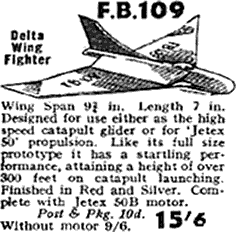 Gamages’s F.B.109 Delta Wing Fighter
- Meccano Magazine, Jan. 1953
|
|||||||||||||||||||||||||||||||||||||||||||||||||||||||||||||||||||||
|
|
|
|||
|
Saturday was the better day, if very quiet, perhaps because it clashed with Woodvale. Howard Metcalfe put in some lovely flights with his Swift and Hunter; I had some good flights, and several bad ones in what appeared to be sink, but the real highlight for me was Andy’s replica Skyleada Comet [right]. Initial test glides had been straight and true, but the first two powered flights indicated the CG needed to come further back behind the motor. Andy waited some time until the power built up (from the well-behaved vintage ICI fuel) for the third attempt, and then launched the Comet with some momentum. The large model climbed steadily to twenty-thirty feet and flew across Old Warden in majestic fashion, unfortunately straight into the trees. I now understand the meaning of ‘bathos’. The realism of flight was impressive, and the antique Jetex 100 hissed steadily with little smoke, so that I was not as aware (as I would have been with a smoky Rapier), that the Comet had but a single motor. It was also evident how much airspace these larger Jetex models need. Damage was fortunately not too severe and the opportunity has been taken to remove some lead from the nose in the repair. It should fly even better next time! There was a very complimentary review of the Comet in a 1953 Model Aircraft ‘Over the Counter’. This began: “Here is a kit that was destined to be a winner before even it got into production – the first commercial flying scale model of the de Havilland Comet. Wisely, British Model Aircraft [aka Skyleada] have kept this a simple model. The problem of multi-jet power has been dodged completely by using a Jetex 100 (or Jetmaster) unit in a trough in the underside of the fuselage. Except for a direct underside view, scale outlines are preserved, whilst a single jet power unit provides all the necessary thrust for flying without the complication (or expense) of trimming with two or more motors.” |
 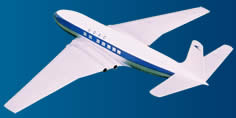 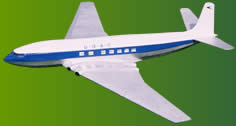 Andy Blackwell‘s replica Skyleada Comet
- Andy Blackwell
|
|||
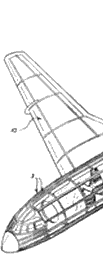
I still think Rapiers are wonderful, despite their operational limitations, variable supplies, and the poor quality control we have seen this year, but the Comet demonstrates why we still need Jetex motors: a smaller Comet trailing exhaust from what is obviously one motor under the fuselage would not be quite the same. As yet there are no viable modern replacements for either the motors or fuel pellets. Though antique motors, fuel and wick appear on Internet auction sites regularly (at a price) supplies will eventually dry up: how then can we fly the larger vintage Jet models? However, all is not gloom and doom; the progress in battery science and EDF will soon allow us to fly our ‘Tailored’ Hunter and Swift replicas at an authentic speed (and unpredictability) – a nice example of cutting edge technology enabling the resurrection of past pleasures. |
|
 |
||
|
Lockheed Lancer Readers may have been a trifle puzzled by my reference in August’s column to a derivative of the Lockheed F-104 Starfighter as the “Canadair CL 1200 Lancer” [corrected in the online version]. I meant, of course, the Lockheed CL 1200-01. Being away from home I did not have access to my reference books; Canadair had built a version of the F-104, I remembered the ‘CL’ prefix and thought, “Canadair”. Oh dear! Kelly Johnson developed the Lancer from the Starfighter at the end of the fifties; as with the U-2, he kept that delightfully shaped fuselage but added new appendages. A second prototype for a turbofan was also made in mock-up and given the CL 1200-02/X-27 designation, but I think this first prototype is more attractive. Note that the larger shoulder mounted wing has been moved aft, and the tailplane set low to minimise downwash and eliminate the F-104’s inherent pitch-up problems. Though Johnson had projected that the Lancer would be superior to any known fighter, with a top speed in excess of Mach 2.5, in the event the competition was won by the Northrop F-5 ‘Freedom Fighter’, and the program was terminated. I don’t think the Lancer has been modelled; if sufficiently large and light it should be a lot easier to trim than any model of the F-104. Ron Pascoe, the designer of the Jetex (Sebel) ‘Mach 1’ F-104, implied that it flew in a “ballistic fashion”. Even so, I don’t think I could persuade Andy to convert his precious Sebel kit into the potentially better-behaved Lancer! |
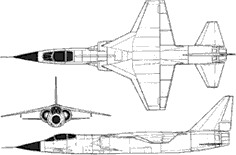 Lockheed CL 1200-01 ‘Lancer’  Sebel F-104 Starfighter (1958) |
|||
|
Magical Mystère Tour Mike Stuart has written more about his Skyleada Mystère IV: “The first flights at the Old Warden Scale Weekend, during the brief lull after the rain showers, were made using an L2 rated at just 100 mN. It showed a slight stall but it actually climbed and looked nice and stable. A bit of noseweight was added, and the second flight, with the same motor, was very smooth with the model settling into a gentle left-hand pattern towards the end of the power run.” It has a smashing glide, and it is hard to believe such a low power could work in such a large model, but I know Graham Potter found something similar with his Easy Built Venom. I will try slightly higher rated motors to see what happens – probably just 105 and 110 mN – as I do not want things to get too exciting! It has made me rethink a bit about these jets – relatively big lightweight models with lots of wing area [and low power] can also be fun!” As Mike Stuart enjoyed his Mystère so much, Andy Blackwell tempted him with a plan for a YF-100 Super Sabre from the same stable. Mike says, with his usual enthusiasm, “I have to say that I really like it, despite Pete Smart doing his best to warn me off. Though only 14” span, it is a relatively large model with lots of wing area.” |
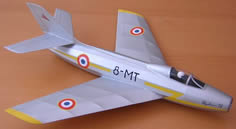 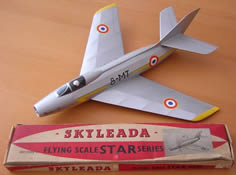 Mike Stuart’s Skyleada Mystère IV for Rapier L2
- Mike Stuart
|
|||
Mike then made some more detailed observations of the plan: “I’m sure the designer is the same [as the Mystère], as the spine, which will need beefing up, is treated the same way. The rather peculiar square-bottomed front is easy to modify. I will cut out the formers as they are without stringer slots and, after assembly, radius them a suitable amount using Mk 1 eyeball. I will sheet the first couple of bays and make the air intake hollow to hide the noseweight. It has better incidence angles between the wing and tailplane and with careful weight management I think this could be a great floaty low-power model. “The plan is of the YF-100 so I intend to finish it as the prototype, with appropriate lettering on the nose. Based on my experience with the Mystère, I am sure a 130 mN rated L2 will have enough grunt, despite the model’s size”. The success of Mike’s Mystère also stimulated me to some reflection. Perhaps the designer of the later Skyleada kits, (who Phil Smith believes was Peter Kelsey) actually knew what he was doing. The instructions stress the need to build light; perhaps Mr Kelsey was of the opinion that larger models made for less critical trimming and happier customers. This is an arguable position; we have perhaps rather lost sight of this approach in the thrill of seeing models like the Sukhoi SU-11 and Fairey Delta 2 zipping about the skies with L2 HP’s of ratings up to 270 mN. Richard Crossley has long advised “just a whiff of power” (‘WOP’) for most scale jets. My Skyleada Hunter was quite stable, and flew practically ‘off the board’, with a 110 mN L2. Very nice it looked too, but, unlike Mike, I could not leave well alone, and in my quest for speed and excitement I tried L2s of 130 and 140 mN ratings. The Hunter became quite twitchy and prone to loop; I had to add more lead to the nose and experiment with micro adjustments of the flying surfaces. Though I did achieve a couple of exhilarating flights, I nearly destroyed the model in the whole frustrating, undignified (and expensive) process. I wonder if it was worth it, given that the old girl (the Hunter is after all more than fifty years old) is really much happier on low power. |
|
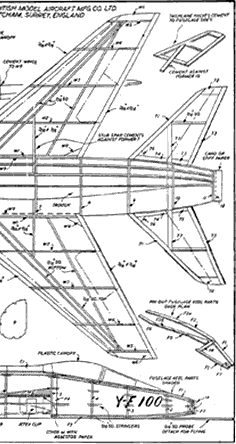 |
||
|
The Jetex Tailored kits, lovely as they were, are remembered as being quite difficult to handle; this was, at least in part, due to their small size and high wing loading. As an example, the ‘Tailored’ Super Sabre [right] was only 7½" span, with less than a third of the wing area of the Skyleada model; indicative of a ‘ballistic’ design philosophy different from the ‘WOP’ approach of Skyleada and Veron (see September’s discussion of Phil Smith’s scale designs). Both the WOP and ‘ballistic’ philosophies are of course valid approaches to model jet plane flying. The spectacular performance of Tony Betts’ replica of John Darnell’s Folland Midge when propelled by an SpaceShipOne |
 Jetex ‘Tailored’ Super Sabre
- Wilmot Mansour poster c. 1955
|
|||
|
Some time ago I lamented that we are not perhaps as adventurous as the Jetex modellers of yore. Though we have made some progress, and both Chris Strachan and Pete Smart have built more twins this year (a lovely Gloster Meteor NF 14 and an evil looking Yak 29P [right] respectively), we have not yet attempted a configuration as unusual as the ‘Plover’ (where the motor was in an underslung pod), or as complex as Paul del Gatto’s Bomarc, which was propelled by a Jetex Scorpion and two 50Bs. There has been some innovation in construction techniques, and I hope to report soon on two models of the difficult but attractive |
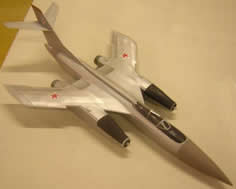 Pete Smart’s Yak 29P Firebar
- Peter Smart
|
|||
|
Stan has been a consistent supporter of the (Jet)X Files, and his aperçus have provoked some useful debates in these columns – for example the relevance of an all-sheet profile prototype to the performance of a ‘true scale’ model (the answer by the way was, er, … probably not very). Now I thought I was in danger of rustication when I wrote about new models of fifties’ jets like the Leduc 21 or Lockheed Lancer for which there was no contemporaneous plan, so I was more than a little surprised Stan would encourage me to consider Burt Rutan’s SpaceShipOne (SS1). Perhaps the old Funf was being an agent provocateur and doesn’t really expect a response. However, knowing his love of elasticated launch techniques, I wondered if a Funf-type catapult glider of this unusual aeroplane might be useful in determining a viable layout for a proper Rapier powered model. There was some discussion of the SS1 on the ModelJetPlane group. Carl Godel drew up a preliminary 3-view from photographs [above right], which I blew up to a span of about 12", suitable for an L2. I showed this to Chris Strachan, and sent copies to Griff Ingram and John Scott-Scott for their comments. The fuselage is unproblemmatical, being of similar size to the Aerographics Bell XS-1, and there is also plenty of wing area. So far so good; but what gave us pause for thought was the rather peculiar arrangement of the horizontal tailplane. Obviously the area is marginal, but the real problem, John pointed out, is that the twin booms will need to be torsion-resistant. Perhaps a tailplane made of thin folded acetate across the booms would address both the lack of tail area and provide some stiffness and be nicely ‘invisible’ in flight. The verdict, then, is that this is an interesting design with definite possibilities whose aerodynamic properties are well worth exploring. I look forward to seeing a photo of Stan’s catapult-launched prototype. |
 Bert Rutan's SpaceShipOne
- Carlo Godel, 2004
|
|||
|
Incidentally, the ‘hybrid’ rocket motor of SS1 may have modelling implications. A PAA-Loader/Jetmaster size motor with solid fuel pellets attached to a nitrous oxide ‘Sparklet’ type bulb (these are sold for whipping cream) as oxidant has possibilities for model rocket propulsion. Such motors would have an extended run time and could be throttled back in flight. The efficiency and power these units could in theory provide would enable one to fly a Skyleada Comet or ‘Tailored’ Swift with (micro) R/C assist, and thereby avoid trees! |
||||
|
|
||||
|
|
|
|||
|
|
|
|
|
|
|
|
Acknowledgements - Article: Roger Simmonds - Illustrations: Roger Simmonds, Andy Blackwell, Simeon Bull, Carlo Godel, Mike Ingram, Peter Smart, Mike Stuart |
|
|
|
|
ABOUT | MOTORS | MODELS | ARCHIVE | HISTORY | STORE | FAQ | LINKS |
|
|
Terms of Use
|
Queries? Corrections? Additions?
Please
contact us.
|
|